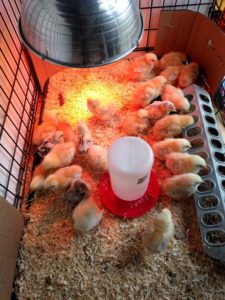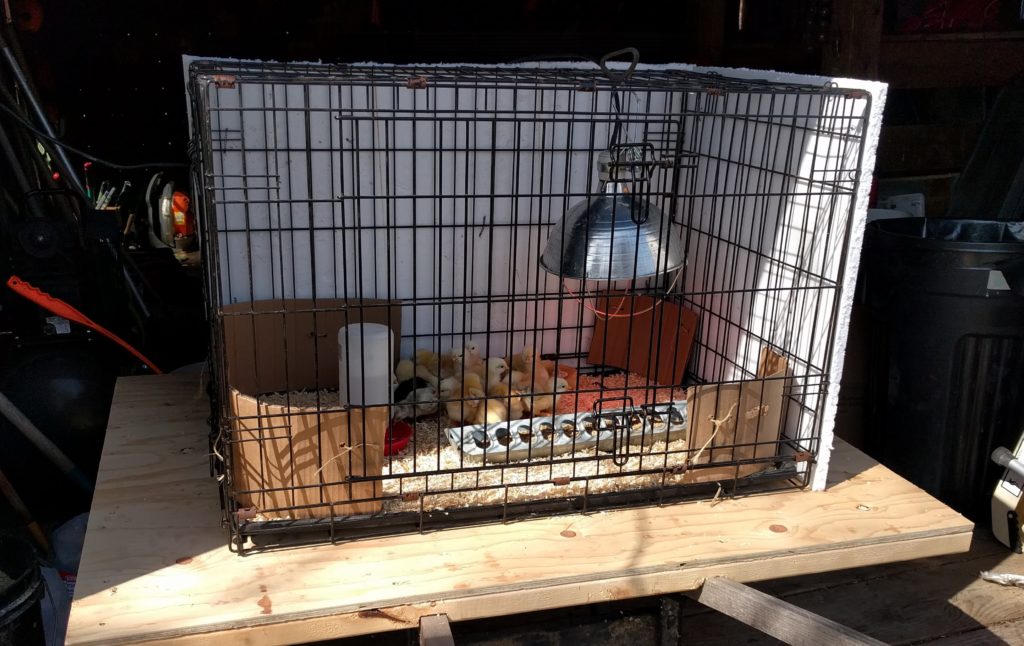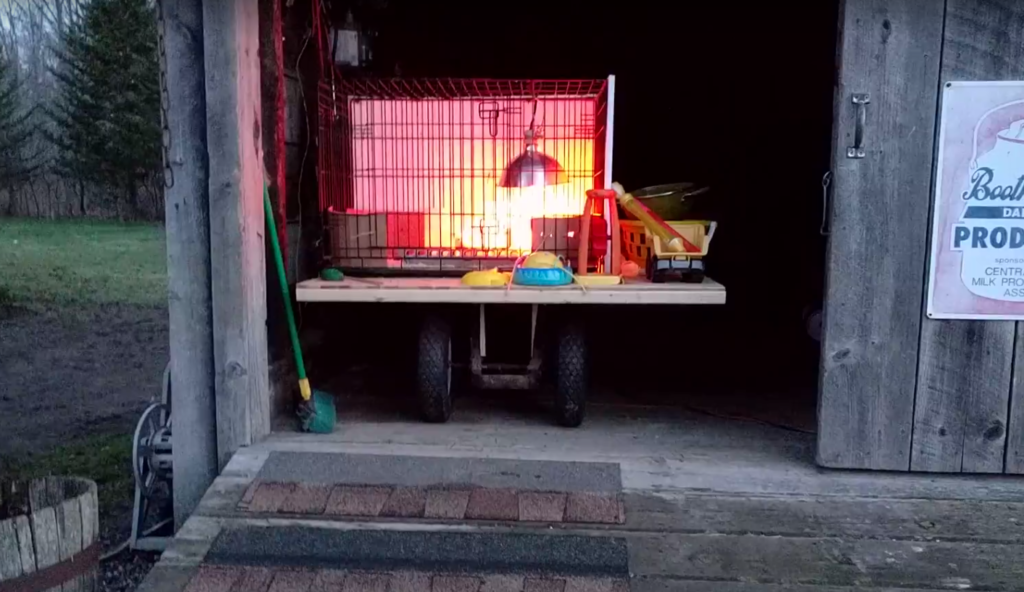Another post in the How to Raise Chickens series, because including chickens in your lifestyle can add value in every domain.
Whether you buy chicks locally, or through the mail, once they arrive you go into brooding phase. There is no ‘right’ way to do it, but there sure are wrong ways to do it. Ask me how I know. Without further ado, How To Brood Chickens.
Recap and a few Reminders
If you ordered birds through the mail, you’ll get a call from the post office and will have to pick them up in person. They are going to be hungry, chirpy little chicks so get them into their brooder as quick as feasible.
Related: Where to buy baby chicks
Once you have them in your brooder, and this now applies to chicks from other sources too, dip their beak in the water so they figure out where it is.
Survival tip up front and out of the way, so now let’s dig into what the brooder is all about.
5 Required Parts of a Brooder
You can setup your brooder however you want. There are loads of options, but make sure you include these five things.
The Enclosure

Floor, walls and a ceiling. You can use a cardboard box, or a prebuilt system from a hatchery or feed supply store. Try to avoid corners (so they don’t pile on top of one another), and make it easy to access the chicks, waterer and feeder.
Size the brooder such that you have plenty of room for the chicks. You’ll find they mostly all congregate together anyway, but make sure they have some space to get away from the heat lamp if necessary.
If you decide to forgo the ceiling, and that is an option, just be prepared for the little guys to jump up and roost on the edge, or fly out.
Bedding
Something to put on the floor to improve the quality of life for the chicks and absorb their effluent. I usually use nice clean wood shavings or planar shavings from the woodshop. For the first day or two cover it in newspaper so the chicks don’t mistake it for food.
Food and a Feeder
Make food available all the time. I have grown accustomed to the long trough style feeders. Choose a food that is best for you, whether that’s all out non-GMO organic, or the conventional feed that cost half the price for twice as much. Your call, I won’t judge.
Include some chick grit in their diet, I usually sprinkle just a little bit on top of the food whenever I fill the feeder. Chicks (and chickens) don’t have teeth so the grinding action on food occurs by collecting dirt and grit in their crop.
MEDICATED vs NON-MEDICATED
Chicks are susceptible to a few diseases that are preventable by vaccination at birth, or medication in feed early in life. You play this game how you want, but I recommend either ordering vaccinated chicks, if that’s an option, or feeding medicated chick feed.
Water
Make sure water is always available too. They’ll get it nasty in a flash by walking in it, spilling it, and pooping in it, so be prepared to change it frequently. Don’t freak out over cleanliness, but it’s a good motto to keep in your mind that if you wouldn’t drink it, they shouldn’t have to either.
Heat
Traditional accomplished with a heat lamp, but a few more modern items are hitting the market. I have always used a heat lamp, so that’s all I’m going to share. Adjust the heat intensity by controlling the height of the lamp above the bedding.
I don’t freak out much about the temperature, but you can buy a thermometer and read up on how the temp should progress as they age. I just keep an eye on how closely they huddle under the light. If they look cold, lower the light, if they’re all out at the edge of the heat band, raise it up a little.
Where to Locate your Brooder
This is one I implore you to learn the easy way.
Our first year raising chicks we brooded them inside in a cardboard box. Some parts were so fun, like when they start chirping when you get home. Some parts were miserable, like the epic volume of dust they create and the speed with which they can stick up fresh bedding.
Or. You can learn the hard way too. Because they’re so cute it’s almost worth it.
How to Brood Chicks
With the brooder installed and the chicks welcomed to their new home, there’s not a whole lot to do.
Food and water all the time.
The more you handle them the more they friendly they will be toward humans.
Clean the brooder frequently. If your brooder allows, I recommend a deep litter method meaning; when you start to smell the stink, you put down a fresh layer of shavings. Otherwise, you’ll probably have to relocate them all to a box to clean out the brooder and then plop them back in when you’re done.
Pasty Bums
Get used to it. You’re going to have to clean the poop off some of the bums. Pay attention to this, it’ll kill them if you don’t. It’s not a big deal, just get a warm damp cloth and wipe the little turds off their bottom. They won’t like it, but if you don’t do it they can get bound up and die.
Case Study: The Wheel BaRooder
This is the current evolution of our brooding system here at the NHM Homestead.
 I took a busted up wheel barrow and turned it into a flat bed.
I took a busted up wheel barrow and turned it into a flat bed.
Then I took a medium sized dog crate, put it on the flatbed, and followed all the directions above.
As our brooding operation evolved, we first learned that we never want to brood in the house again. So, we used a stall in the barn. But in the stall, the chicks got very little sunlight, and that made us feel bad. So with the Wheel BaRooder I can still keep them in the barn, but I can roll them out on nice, warm days so they get to experience sun and fresh air.
It’s actually really nice to be able to move them around, and it gets them up off the ground which makes it easier to clean the brooder, and handle the chicks.

Feel free to run with the idea, please share your journey.
Speaking of that!
Enjoy the journey!
Have fun with the little chicks. Make sure your kids can hold them. Grab some pictures and do it fast because they grow up quick.
Use this time to make sure their coop will be ready for them.
They’ll be ready to move out once they are feathered out. You’ll know if they’re overstaying their welcome in the brooder.
If you are introducing chicks from a brooder to a coop that already has chickens, it’s best to sneak them in at night. Sometimes chickens don’t take well to new flock members. I’ve always done it under the cover of darkness and have never really had an issue.
If it’s your first time brooding chicks introducing them is clearly not an issue, but you should be thinking and planning your chicken coop well in advance of getting chickens. That will be next in the series of How to Raise Chickens.
Stay tuned, make sure you subscribe.



